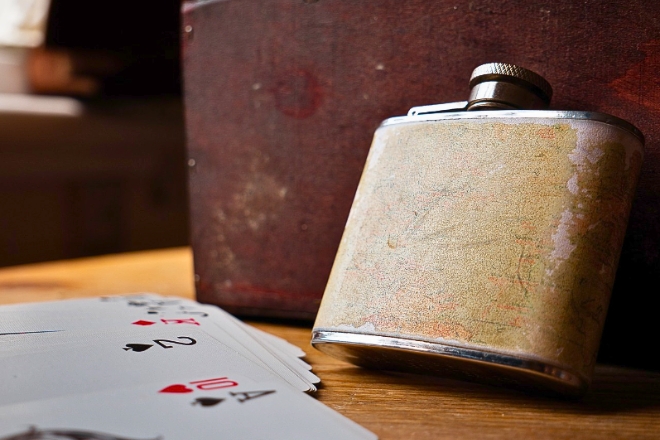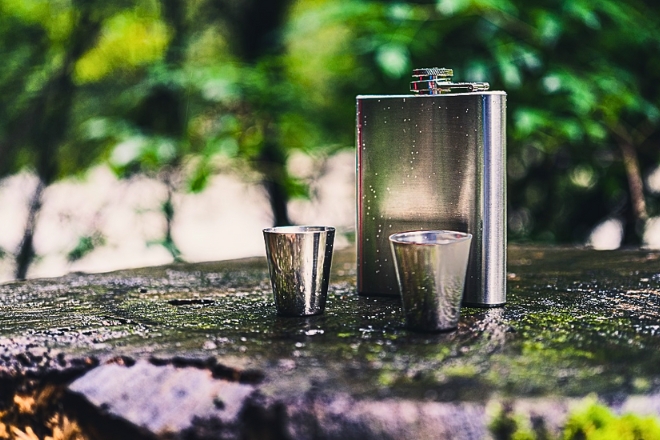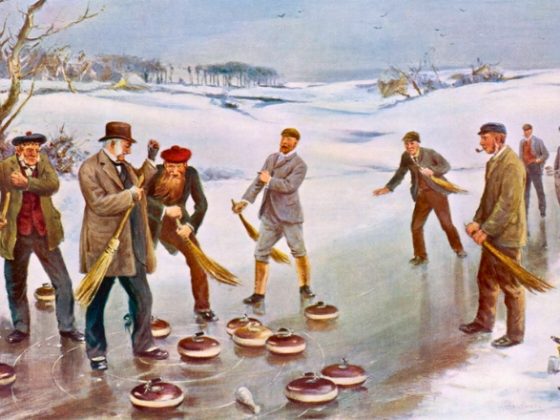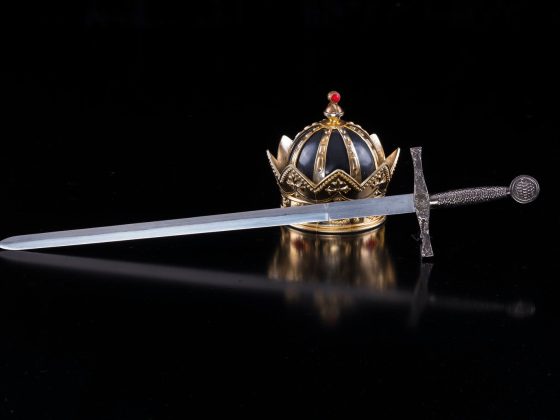The Secret History & Revival of Hip Flasks!
Hip flasks—those elegant, concealed containers found in coat pockets and handbags—are not merely vessels for spirits; they represent enduring icons of style and cultural identity. As we peel back the layers of their storied past, we uncover a fascinating narrative that spans centuries, continents, and social strata.

From their utilitarian beginnings to their status as a staple of modern-day chic, hip flasks have evolved, reflecting and adapting to the changing tastes and technologies of the times. This deep dive explores their development, the aesthetic influences on their design, and their vibrant resurgence today.
The Storied Past of Hip Flasks!
The hip flask boasts a storied past that spans over 60,000 years, beginning when hunter-gatherers in Southern Africa utilized ostrich eggshells as makeshift containers. This primitive necessity evolved through the ages from simple earthenware in 2000 BC to sophisticated metals and glass, becoming an essential personal liquid carrier across diverse cultures. By the 1700s, British women ingeniously smuggled spirits using pig’s bladders, paving the way for the hip flask’s rise to prominence in 18th-century England, where it became as fashionable as the pocket watch. The tradition of concealed spirits continued, and during the Prohibition era in the U.S., hip flasks symbolized defiance as they discreetly carried alcohol into speakeasies. Despite today’s challenges with open container laws in modern America, hip flasks remain treasured gifts for special occasions like weddings and graduations, predominantly crafted from durable stainless steel. Historically used for carrying water and alcohol, which served practical purposes like preservation and sterilization,

Today’s flasks primarily hold spirits for social enjoyment. From being a crucial tool for Crusaders in the Middle Ages to a Victorian era status symbol, and even saving a soldier’s life by deflecting a bullet in World War II, hip flasks have proven their worth as indispensable everyday carry items, reflecting a rich and varied legacy.
The Ascension of Hip Flasks:

Hip flasks originated in the 18th century among Europe’s elite, crafted initially from glass, leather, and porcelain. These early versions were not only practical for carrying medicinal spirits but also served as a handy refreshment tool during outdoor activities such as hunting and horse riding. Although various containers for liquids have been used for centuries, it was during this period that the specific design of the hip flask was conceptualized, blending functionality with elegance. Of course, liquid flask in some form has been used for many 100’s of years before this but
the idea of a hip flask came into play around the 18th century.
Aesthetic Evolution: The Changing Materials & Designs
As civilization progressed, the composition and styles of hip flasks underwent significant transformations. The initial versions, crafted from glass or porcelain, were eventually replaced by sturdier, more travel-friendly alternatives such as pewter and stainless steel. These metals not only enhanced the flasks’ resilience but also allowed for more elaborate design features. Engraved motifs, custom inscriptions, and ornamental details soon became sought-after enhancements, adding a touch of personal flair to these practical items.
Icon of Anecdotes: Cultural Resonance of Hip Flasks
Hip flasks carry a rich cultural symbolism, serving as emblematic artifacts throughout history. In the throes of battle, they provided soldiers with a small comfort and a taste of solace. In the realms of literature and cinema, these flasks are often the hallmark of characters marked by adventurous spirits, rebellious hearts, or a sophisticated air. Moreover, the gesture of sharing a sip from a hip flask among friends has evolved into a meaningful ritual, representing friendship and a deep sense of connection.

Why is it called Hip Flask?
The term “hip flask” is imbued with a storied past, reflecting both clandestine utility and a sophisticated aesthetic. First gaining popularity in the 19th century, the hip flask’s origins can be traced to the 18th century, when women ingeniously concealed gin in makeshift flasks crafted from pig’s bladders as mentioned earlier. As met with the onset of the 1920s Prohibition era, it emerged as a potent symbol of defiance—a covert means for individuals to circumvent the era’s rigorous alcohol prohibitions. Its distinctive, curved design is purposefully crafted to align with the contours of the human hip, providing both comfort and stealth by minimizing visibility under clothing. Hip flasks, as the name implies, are often discreetly carried along one’s hips, tucked into pockets, belts, waistbands, or even Kilts. These flasks come in various shapes and sizes but typically feature a curved design to conform comfortably to the wearer’s hip or thigh, ensuring both comfort and stealth. Many contemporary designs include captive tops to keep the lid attached and prevent loss—a practical feature given their intended use. Whether in Scotland or America, these flasks integrate seamlessly with local attire, including kilts, making them a versatile accessory for discreet beverage transport.

Today, the hip flask not only continues to represent personal liberty and the pursuit of pleasure but also serves as a nostalgic artifact, echoing a time when its possession was both an act of personal defiance and a bold statement against restrictive norms.
Hip Flasks During Prohibition: America's Speakeasy Staple
During the Roaring Twenties, as Prohibition took hold, Americans developed crafty methods to keep spirits at hand, leading to the rise of the hip flask, a fashionable accessory secretly carried by both men and women. This era saw men tucking flasks into their boots and women into their garters, a practice that humorously contributed to the term “bootlegging.” The hip flask became such a symbol of rebellion that by the 1930s, it was not just a tool for clandestine sipping but also a stylish urban accessory, eclipsing the pocket watch as the wristwatch became the new norm for timekeeping.

Those who carried them, often referred to as “hipsters,” a term that originally described Prohibition-era flask carriers, were playfully nicknamed “vial villains” or sufferers of “hip disease.” This period of covert defiance even saw states like Indiana banning the sale of hip flasks and cocktail shakers to curb their proliferation. As World War II approached, soldiers adopted these “pocket pistols,” and RAF pilots humorously called their service revolvers “hip flasks,” highlighting the item’s ingrained presence in American culture and its lasting legacy as a symbol of discreet indulgence.
Hip Flasks' Modern Renaissance:
In recent years, hip flasks have made a fashionable comeback, transforming into must-have accessories for more than just whiskey aficionados. These elegant vessels are celebrated not only for their utility but for the exquisite craftsmanship they exhibit. Available in an array of designs, dimensions, and finishes, modern hip flasks offer everyone the opportunity to showcase their taste. The addition of custom touches like engraved initials or bespoke designs further enhances their appeal, establishing hip flasks as exceptionally thoughtful and personalized presents.

“Frequently Asked Questions”
The main purpose of a hip flask is to carry a small amount of liquor or other alcoholic beverages discreetly and conveniently. Hip flasks are typically flat and curved to comfortably fit in a pocket, making them ideal for personal use at events or locations where carrying a full bottle might be impractical or prohibited.
A liquor hip flask is a small, portable container used specifically for carrying alcoholic beverages. It is generally made from metal—such as stainless steel or pewter—and is designed to be both durable and leak-proof. These flasks are often used to carry spirits such as whiskey, bourbon, or brandy, as their sturdy construction helps preserve the flavor and quality of the alcohol.
Hip flasks themselves are legal in the US; however, the legality of carrying one filled with alcohol depends on local laws regarding open containers and public consumption of alcohol. In many places, having an open container of alcohol in public spaces is illegal, which would include alcohol in a hip flask unless it is kept in a location like a private car or backpack.
Spirits such as whiskey, bourbon, brandy, and rum are popular choices for carrying in a hip flask. These high-proof alcohols are less likely to degrade or change flavor over time, especially if the flask is not frequently opened.
While it is a stereotype that all alcoholics carry flasks, some may do so to have constant, discreet access to alcohol. Carrying a flask allows for easy concealment of alcohol, facilitating consumption in settings where it might otherwise be socially unacceptable or illegal. However, not everyone who carries a hip flask has a problem with alcohol; many do so for convenience and personal enjoyment.
Hip flasks are safe for carrying alcohol as long as they are made from materials suitable for storing spirits. Flasks made from food-grade stainless steel or pewter are safe and will not react with alcoholic beverages. However, flasks made from inferior materials or certain metals like lead can be harmful. Always ensure that the flask is designed specifically for storing liquor.
To fill a hip flask, you typically use a small funnel to pour the liquor into the flask’s narrow opening. This helps prevent spillage. It’s important to fill the flask only to just below the neck to avoid leakage when it is sealed. After filling, make sure the cap is tightly closed to prevent spills and preserve the alcohol’s quality.









